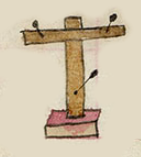crucifijo (CST5)
This painting of the simplex glyph for the term crucifijo (a Spanish term taken into Nahuatl, meaning crucifix) shows a frontal view of a brown wooden cross with three large metal nails or stakes that symbolize the crucifixion of Jesus Christ. The companion text explains that it cost 17 pesos to build this cross, which would have stood in or near the town’s church. This is one of the many new objects acquired to outfit a new Christian church in Texupan.
Stephanie Wood
This is a rare contribution to the hieroglyphic collection, showing the growing acceptance of Christianity and its accouterments. For other Christian crosses, see the glyph for a marketplace (tianquiztli), the appearance of churches (still called teopantli) with crosses on top, the use of the cross as a landmark atop a hill, and a glyph for a surname that includes a broken cross! For more on the Codex Sierra, see Kevin Terraciano’s study (2021).
Stephanie Wood
1550–1564
Jeff Haskett-Wood
cruces, crucifijos, adquisición, compra, iglesia católica

crucifijo, a crucifix (a loan taken into Nahuatl from Spanish), https://nahuatl.wired-humanities.org/content/crucifijo
crucifijo
Stephanie Wood
Códice Sierra-Texupan, plate 5, page dated 1552. Origin: Santa Catalina Texupan, Mixteca Alta, State of Oaxaca. Kevin Terraciano has published an outstanding study of this manuscript (Codex Sierra, 2021), and in his book he refers to alphabetic and “pictorial” writing, not hieroglyphic writing. We are still counting some of the imagery from this source as hieroglyphic writing, but we are also including examples of “iconography” where the images verge on European style illustrations or scenes showing activities. We have this iconography category so that such images can be fruitfully compared with hieroglyphs. Hieroglyphic writing was evolving as a result of the influence of European illustrations, and even alphabetic writing impacted it.
https://bidilaf.buap.mx/objeto.xql?id=48281&busqueda=Texupan&action=search
The Biblioteca Digital Lafragua of the Biblioteca Histórica José María Lafragua in Puebla, Mexico, publishes this Códice Sierra-Texupan, 1550–1564 (62pp., 30.7 x 21.8 cm.), referring to it as being in the “Public Domain.” This image is published here under a Creative Commons license, asking that you cite the Biblioteca Digital Lafragua and this Visual Lexicon of Aztec Hieroglyphs.





